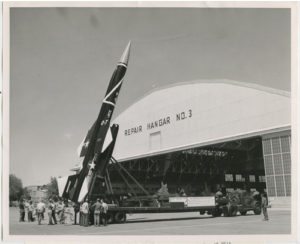Hill Air Force Base
FKA Ogden Air Depot, Hill Field, Ogden, UT

Salt Lake Tribune file photo
Bombers and fighters fill an empty field at Hill Air Force Base, then called Hill Field, in 1945.

Salt Lake Tribune file photo
P-47s are built in a hangar at Hill Air Force Base in 1945.

Salt Lake Tribune file photo
The original caption on this 1959 photo says: “The BOMARC missile, shown on display at Hill AFB, is another weapon for which the Ogden Air Material Area has AF logistic support. Other missiles in OOMA’s arsenal are the GAM-87, a guided air-launched missile: Minuteman, Snark, and Genie air-to-air rocket.
Jobsite
Hill Air Force Base was opened in 1934 in Ogden, Utah. Originally named Hill Field, the base was first managed by the Army Air Corp (AAC) prior to the AAC’s being reorganized as the U.S. Air Force in 1947. Throughout its history and into the present, the Hill Air Force Base has played a critical role in military operations by maintaining and storing a wide array of aircraft.
Address or general location
Ogden, Utah
Detail
Since its opening in 1934, the Hill Air Force Base (HAFB) has played a critical role in U.S. military conflicts. At its peak, the HAFB employed as many as 22,000 military and civilian workers making it the largest employer in the state of Utah. Named in honor of Major Ployer Peter Hill, the base was initially called “Hill Field” and was operated by the Army Air Corp prior to its becoming the U.S. Air Force.
The HAFB’s primary function is to serve as a maintenance and supply base for the U.S. Air Force. From repairing to storing active or retired aircraft, the base has played a vital role in all military operations, including those today. In its early history, the base worked on such planes as the B-17, P-40 and B-24. Beginning in the 1950s, jet aircraft such as the F-84F Thunderstreak and F-89 Scorpion were supported at the base. Later, HAFB supported the Advanced Intercontinental Ballistics Missile System. Over time, the HAFB has evolved to accommodate the advances in aircraft technology and to support the U.S. Air Force’s role in military operations.